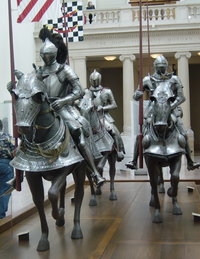
 |
Search TheMiddleAges.net |
Armor |
||
Armor (also spelled Armour), is protective plates or clothing meant to shield a human from intentionally inflicted harm. Armour has been in use for all recorded history, beginning with hides, leather, bone, progressing to bronze, steel, ballistic cloth, ceramics, and depleted uranium. Armour has been primarily a way to protect oneself from harm in combat and military engagements.
 Armour was also commonly used to protect war animals, such as war horses and war elephants, from intentionally inflicted harm. Armour, historically, was used to refer to any heavily armoured unit (heavy infantry/cavalry vs. light infantry/cavalry.) History In European history, common armour types were the lorica segmentata, the chainmail hauberk, the gambeson and later the full steel plate armour used by late medieval knights. In feudal Japan, laquered odoshi armour, a form of lamellar, was popular. Plate Armor Full plate armour was very expensive to produce and remained therefore restricted to the upper strata of society, and lavishly decorated suits of armour remained the fashion with 17th century nobles and generals, long after they had ceased to be militarily useful due to the introduction of firearms in the battlefield. Reduced plate armour, typically consisting of a breastplate, a burgonet, morion or cabasset and gauntlets, however, became also popular among 16th century mercenaries. From the 16th century on, armour specifically designed for jousting Evolution of plate armour also triggered developments in the design of offensive weapons. While they were effective against cuts or blows, they could be pierced by bolts fired by powerful crossbows, and also by long-tapered designed for the purpose. Maces could be used not to pierce the armour, but to inflict blunt traumata in spite, and through, the armour. The weak points of plate armour (compared to chainmail) were the joints, where the plates overlapped, but would expose unprotected gaps in certain stances of the wearer, through which gaps sword and dagger blades could penetrate. In the armoured techniques taught in german school of swordsmanship, the attacker concentrates on these cracks , resulting in a fighting style very different from unarmoured sword-fighting. Because of that weakness, it was common to wear a shirt of chainmail beneath a plate armour. The armpits could further be protected by round plates called besagews. Plate armour could have consisted of a helmet, a gorget, pauldrons, couters, vambraces, gauntlets, a back and breast plate with a culet, a fauld and tassets, a skirt, cuisses, poleyns, greaves and sabatons. While it looks heavy, a full plate armour could be as light as only 40 pounds if well made, and so well spread over the body that a fit man could run, or jump into his saddle. That it was necessary to lift a fully armed knight onto his horse with the help of pulleys is a myth originating in Mark Twain's A Connecticut Yankee in King Arthur's Court, and has no historical base. Even knights in enormously heavy jousting armour were not winched onto their horses. This type of "sporting" armour was meant only for ceremonial lancing matches and the design had to be extremely thick to prevent severe accidents, such as the one causing death king Henry II of France. |
Related Links: |
|
| This article is licensed under the
GNU Free Documentation License. You must provide a link to www.gnu.org/copyleft/fdl.html. All other content is copyright © 2011 by TheMiddleAges.net |